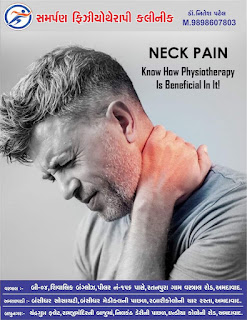 |
| Neck Pain Physiotherapy Treatment |
Treatment varies for everyone depending on the cause and severity of neck pain, but one remedy that most people can benefit from is exercise. People can take steps to relieve neck pain at home by using over-the-counter (OTC) pain relievers such as acetaminophen (Tylenol) and ibuprofen (Advil) and staying active. Most neck pain physical therapy programs include treatments that reduce pain and/or stiffness enough to initiate a neck strengthening and stretching exercise program. The time it takes to treat each condition varies, but a personalized physical therapy plan can be effective and efficient, and help heal neck pain within a few weeks.
If you have neck or arm pain that comes from the neck, your doctor may refer you to physical therapy. Pain radiating from the neck can be felt in different places, which can make your condition confusing and difficult to treat. If you feel pain in your arm that originates in your neck, you may experience weakness in certain muscle groups in your arm.
Neck pain can often also be felt in the shoulder blade area, and other types of shoulder pain can also come from the neck. The neck is also vulnerable to conditions that cause pain and restrict movement. Rest the painful area, avoiding activities that cause symptoms to worsen in the neck or arms.
If tense and aching muscles are thought to be the cause of neck pain, your physical therapist may use massage techniques to relieve tension and pain in those muscles. Your physical therapist may prescribe certain exercises to help you improve mobility and reduce neck pain. Cervical traction can sometimes be used in a physical therapist's office or on the recommendation of an orthopedic or neurosurgeon to treat neck pain.
Mechanical intermittent traction of the cervix as an intervention for chronic neck pain in adults has not shown a particularly favorable effect compared with standard physical therapy interventions. Numerous studies have examined whether physical therapy can help reduce pain associated with the spine, such as the lower back or neck. In these cases, physical therapy can help manage stiffness, improve neck function, and reduce or prevent painful cramps as the muscles recover. Although pain cannot be completely eliminated, physical therapy can play an important role in improving posture and neck function as part of daily exercise.
Exercise can help reduce pain, increase mobility, and strengthen neck and postural muscles. Exercise can also help reduce neck tension and increase the range of motion in the neck. Regular exercise can help patients improve mobility and strength, minimize recurrence, and reduce the severity and duration of possible future episodes of neck and arm pain. Gentle neck exercises can help when pain occurs, as can heat or ice packs to help manage symptoms.
Current medical literature provides moderate to strong evidence supporting the role of physical therapy in reducing neck pain and improving range of motion. - Some studies suggest that physical therapy benefits are greater when combined with other therapies such as aerobic exercise.
Practical Tips Patients with typical neck pain may benefit from a physical therapy program that includes exercises combined with neck activities and upper back manipulation. The researchers concluded that neck mobility and upper back manipulation exercises were most effective in reducing pain during the first week of treatment. After 1 week, patients who exercised and received neck mobility and upper back manipulation noticed increased neck pain. When patients received neck mobility alone, only 19% experienced pain reduction and only 23% experienced improvement in disability.
A study report published in the March 2013 issue of the JOSPT journal JOSPT focused on finding which combination of exercise and manual therapy was most effective in rapidly reducing neck pain.
Regardless of the origin of the symptoms, athletes with neck pain may have deficits in muscle recruitment, 8,20 strength and endurance, 38 repositional acuity, 27,46 postural stability, 33 or oculomotor control 49. Athletes with neck pain may also have deficits in mobility in cervical and/or upper chest.7 Increasing evidence supports exercise therapy for disorders associated with neck pain.39,43-45,48,53,58,59 Trials Randomized controlled trials comparing different exercises or exercise protocols with athletic populations. For example, if a cancerous tumor is causing neck pain, exercise will not reduce the size of the tumor, but instead the problem may grow and get worse.
In most cases, a physical therapist can develop a personalized treatment program to relieve neck pain—even severe radiculopathy (pain that radiates from the neck to the arm or hand)—to help people with neck pain avoid surgery. If you have neck stiffness due to improper sleep, muscle strain due to an injury such as a whiplash injury or a herniated disc, you have options for treating neck pain. Exercises to Strengthen Postural Muscles Strengthening the postural muscles—muscles in the neck, shoulders, and back—can improve recovery from neck pain and prevent future injury. Exercises to relieve muscle tension Stretching the neck can help a person relieve muscle tension and improve range of motion.
This can be combined with stretching the shoulder girdle and neck, as well as strengthening and strength exercises for the shoulder girdle and neck. Finally, you should use weight-bearing exercises for the neck, shoulder girdle and torso, for example. Practitioners should also aim to improve adherence to the program, which has been shown to improve with the inclusion of chest manipulation, neck exercises, and strengthening of the scapulo-thoracic region and upper limbs.
In addition to their own cervical muscles, the axial-scapular muscles (levator scapula, trapezius muscle) affect the cervical spine and shoulder girdle.
The most common pain caused by muscles is associated with neck tension that affects the neck muscles and tendons, or sprains that overstress or tear these structures.
No comments:
Post a Comment